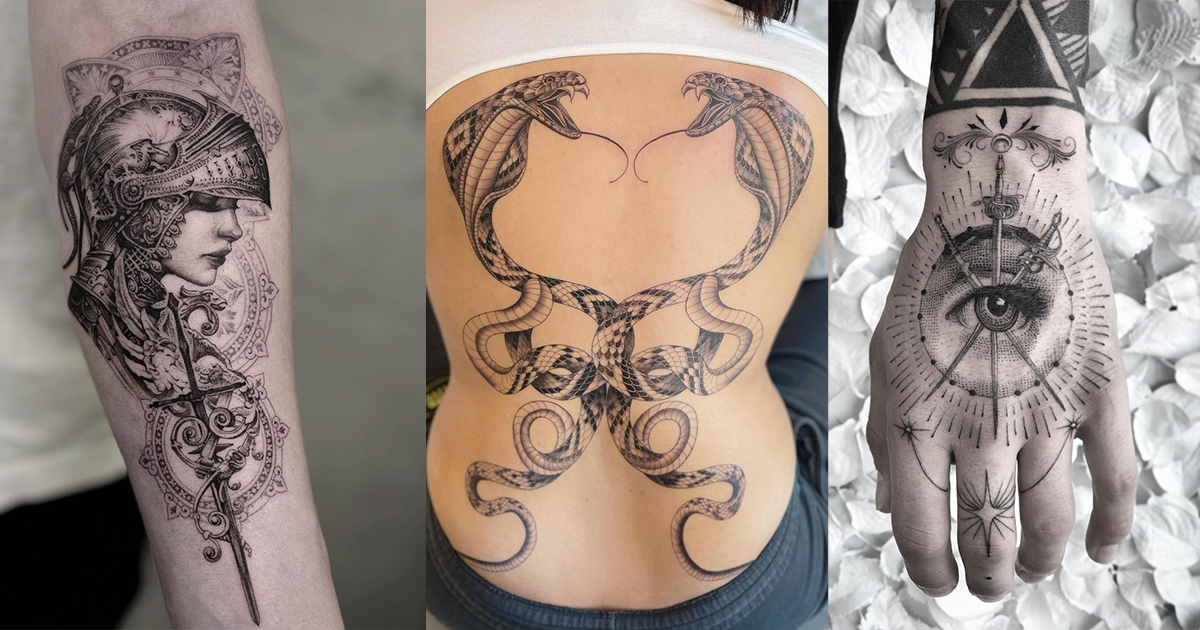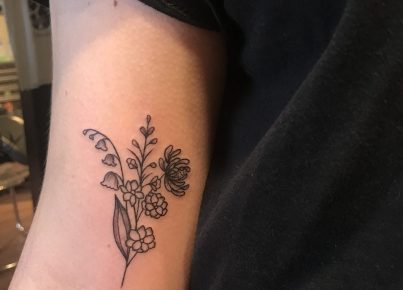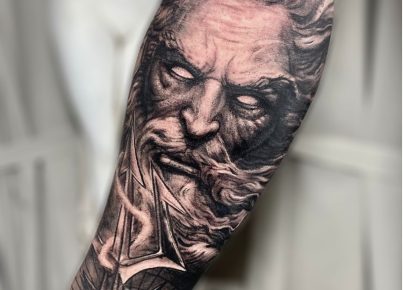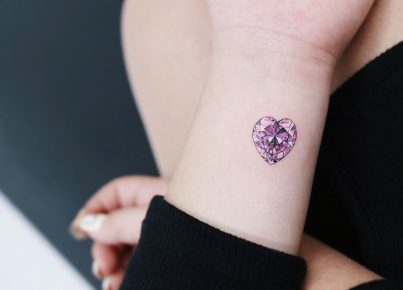Thanks to social media and publications like our little tattoo magazine/website, it’s becoming increasingly rare to come across a tattoo that stops you in your tracks, leaving you bewildered by its genius. But when I saw a piece Amalie Arsinevici created featuring a snake comprised of 69 hands shooting the bird [scroll down to see it], I was completely shellshocked. I had rarely seen anything so brash but also beautiful, in my life.
We got a chance to catch up with Amalie and ask her all about that tattoo, the value of creating art in a rainforest and much more.
Can you introduce yourself and tell us a little about who you are?
My name is Amalie Arsinevici, I am a 31-year-old Tattooer from Denmark, and I go by NightHawk on Instagram. Not really… but something as inventive as AmalieInk. I’ve been tattooing for just around 12 years, and during that time I have tattooed in Denmark as well as various countries in Europe and Japan. I’m an ex-martial artist, hopefully future ceramics maker and master of saying stupid shit on your YouTube channel, that I thought would be cut.
When did you first become interested in art?
I don’t remember not being interested in art, it’s something I was raised with. My parents have bookshelves upon bookshelves filled with art books that range from directions such as surrealism, impressionism, post-modernism, art nouveau, Pre-Raphaelite and many others, which still are a great inspiration to me to this day.
My dad practices Tibetan Buddhism, and shared symbolism from Buddhism and Hinduism through books and his own photography from Tibet, Bhutan, Nepal and India; and this connection drew me to some of the references that roam around my head today. Art was always given a major significance in my household, so more or less consciously, it stuck with me.
What made you want to become a tattooer?
“Miami Ink.” What’s good?
How did you start tattooing? Did you have an apprenticeship?
I had posted some of my drawings on Facebook back in 2011, and somehow this drew the attention of the man who ended up becoming my teacher, Mark Wosgerau of Sinners Inc in Denmark. I apprenticed with him for three years, before moving to Copenhagen in the pursuit of love.
What is the tattoo scene like in Denmark?
The tattoo scene is quite prolific despite its cute size, and Copenhagen is home of the world’s oldest still functioning tattoo parlor—Tattoo Ole—which opened back in 1884. The legacy of traditional tattoos is still very prevalent in Copenhagen, and in general—in my humble opinion—the Danish tattoo scene caters more towards traditional, neo traditional and more large-scale black-and-grey, than for example the kind of work I do, which would be categorized more as fineline.
How did you come to find your current style? What drew you to fineline black-and-grey?
I’ve been through a plethora of styles, and if you go back far enough on my Instagram page, you’ll see what I’m talking about. My current style is a patchwork of the many techniques I’ve gone through, varying from neo traditional to dot work to realism.
I was drawn to fineline black-and-grey because it felt natural to me. The intricacies that would stress out other people are incredibly rewarding to me, and what some people find to take too much patience, is a fun checklist for me, because my tattoos consist of many elements. This means that my ADHD reward system goes “DING!” So many times throughout a tattoo—every time I finish one element, and this means I can keep going forever, and often do.
What is the most difficult aspect of working in fineline black-and-grey?
For me, it’s knowing when to keep it simple. I tend to hyperfixate on areas and make all parts detailed, where in reality the tattoo usually looks more striking if the eye also has areas to rest. This is why I often leave large skin breaks in my tattoos.
Another challenge is finding clients who not only appreciate the style, but appreciate the fact that this style is very time consuming and that you won’t get a sleeve done with me in three days; which comes with a price tag that not everyone is accustomed to.
What are some tattoo motifs you’ll never get sick of doing?
Womennnnn, above all But every time I see some kind of human figure in my schedule I’m stoked. Faces and bodies will forever inspire me, and in general [a subject] that draws on a classical approach to anatomy and musculature is very satisfying to me. I also love tattooing inanimate objects, as these often have an interesting texture; whether it be the leather on a shoe, the glossiness on a phone, transparency of a veil or what have you.
What are some tattoo motifs you hope to never do again?
LOL. I’m of the belief that it’s a good challenge to have to reinvent images that don’t necessarily excite you at first glance. However, the closer we get to a lion with a crown, pocket watch and roses-combo, the more you can be assured that it will be a very different interpretation than what you’re used to seeing. Speaking of lions, I don’t think I’m great at tattooing fur, so I hope for a limited amount of that I guess.
Have you ever considered working in color? Do you see yourself doing so in the future?
I used to do mainly color actually, and I still fuck around and do it every once in a while. Mostly on existing clients and friends, who’ve had color work done by me in the past. But yes, if the task at hand makes sense for what I believe I can execute to a level that allows me to sleep at night, I’m very open to the conversation. I especially like using colors when doing coverups.
The fuck snake you did for Snuffy is one of my all-time favorite tattoos. Can you tell us a little behind how it all came together?
Appreciate you for that, thank you. It’s also a tattoo that’s very dear to me. The idea came in the wake of a conundrum of fuckery that occurred in Snuffy’s professional life, and called for a reaction. Here, 69 fucks seemed appropriate. We created the design together using Cinema 4D; something Snuffy has quite the firm grasp on, where my role was more that of a project manager with a bunch of opinions. I chose the angles and light source I felt matched my style the best, but the idea was Snuffy’s brainchild.
We wanted to make something really cool that could still be finished before my lunch reservation, and we successfully did that.
Can you walk us through how your design process works?
The process I just described is in no way representative of how I normally do things, but I would love to do it more.
Usually I have an idea and/or story provided by my client, and after familiarizing myself with this, I’ll browse through my extensive online, as well as memory, fuelled library. This is the most time consuming part of the design process for me. It’s not uncommon that I save around a hundred references for a tattoo, and while I’m doing this, I’m visualizing the different directions I can take the design. Once I start designing, using Procreate, I might only touch a quarter of what I saved, but I need to go through that sorting process, and it ultimately saves me time when I’m finally designing. I might use three hours finding references, and then 30 minutes designing. I rarely use less than 20 references, and like to stitch a lot of things together. If I have an otherwise perfect reference of a woman, but she has an uninteresting hand, best believe she’s getting a transplant.
Can you tell us about the Remote Tour?
The Remote Tour is an artist retreat I created in collaboration with my partner in crime and fellow tattooer, Mads Thill, and Art Villas Costa Rica.
We are a combination of tattooers, painters, sculptors, musicians, videographers and other creatives, who meet up at this gorgeous resort in the Costa Rican jungle and make it our home for a few weeks. So far we have been a majority of tattooers, but that’s simply because our network is strong within that sphere, but in the future we’d love to see as many creative directions as possible. This is why we like to stay vague when it comes to our definition, as the more words we add, the more ideas you can tend to exclude, and the people we can learn the most from, we most likely don’t even know who they are yet.
But practically, we as creators, along with tattoo clients and friends who come along, live, eat, create, explore and celebrate together for the duration of the tour. We provide everything you might need for tattooing, and work with an art depot that supplies us with whatever might be relevant for that specific tour.
The schedule is very customizable, and you can work as much or as little as you want, but the surroundings and company always catalyzes way more projects than first expected.
My partner, Mads, put it quite beautifully—the message is that you have no idea how good you are. The Remote Tour has proven to be a great facilitator to familiarize people with their own capabilities and capacity to inspire.
What do you get out of going to an artist retreat, as an artist? How does the collaboration/setting affect your art?
Everyone who has been a guest at The Remote Tour will have a different answer, and we like it just like that. The setting has an overwhelming effect, and it never ceases to amaze me what it does. As artists, many of us have the ability to travel with our craft, and allowing ourselves to work in breathtaking settings confronts you with the life you have created at home, and allows you to see your everyday life more clearly. Because of that, you can make a conscious decision of whether you’re doing what you need to do for your creativity to be nurtured in the most optimal way, while being put in a room (or a rainforest) with people who have completely different skill sets than yourself.
How do you find your references? Do you take any of your own?
Like many other tattooers, Pinterest is my best friend. However, I’ve come to notice how my library is organized a bit differently than most of my coworkers, and more specific. So instead of having a board that’s called “people,” I have “eyes,” “hands,” “dynamic poses,” “profile” and so on, so I can easily navigate those bajillion photos I have saved.
When I get the chance to take my own photos, I take it. It’s very satisfying to create a tattoo of say a sculpture, but it’s captured from an angle you don’t normally see, or in different lighting. I hate reusing references, so this is a great way to combat it, when we’re talking about popular subjects.
Where do you see your art going in the future? Do you work in any mediums other than tattooing?
I’m currently working on a sleeve for a friend and client of mine and Snuffy’s, named Josh. This sleeve is something new for me, and really shows what I find tremendous joy in creating, and I’d love for it to help define the immediate future of my tattoos.
I’ll have the chance to work more closely with one of my best friends, Oscar Akermo, someone who has inspired me throughout my entire career, and I’m sure that will have an influence on my tattooing as well.
I’d love to learn more from Snuffy when it comes to animating, and I’m also working on a few collaborations within fashion that I’m excited to share. Besides that, I would love to have the surplus to draw and paint more, and my dear friend Loady is inspiring me to get into making clay sculptures.
What do you think you’d be doing if you weren’t a tattoo artist?
If I wasn’t a tattooer, I would definitely do something else that could be described as a craft. I like the tangibility and need to see the product of something I produced. I can see myself being a woodworker, doing ceramics, but also being a horologist, as I have an inkling for watches and can see my steady hand and attention to detail being transferable to that craft. Furniture making because of my Scandinavian heritage, ceramics due to my love of Japan and haute horology because it is my father’s passion that was passed down.






